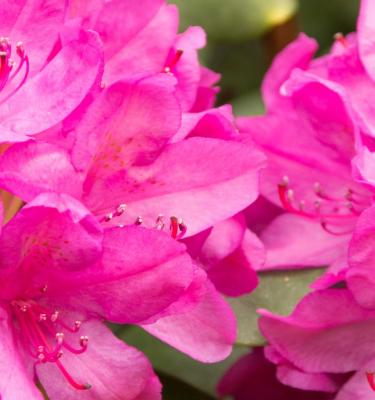

How to grow and care for rhododendron
Rhododendrons are spring flowering shrubs or trees that are closely related to azaleas, so they like similar growing conditions. They are loved for their masses of flowers in reds, pinks, whites, purples, and oranges.
Rhododendrons prefer cooler climates and grow in a sheltered, semi-shaded spot with gentle morning sun, however, if you live in the subtropics or tropics try the Vireya rhododendrons which are more suited to warm rainforest-like conditions.
Top 5 steps to growing rhododendron
- Rhododendrons prefer a part shade spot, with gentle morning sun. Too much sun will burn the leaves and flowers.
- The trick to growing perfect rhododendrons is a compost rich soil that is slightly acidic with good drainage.
- Prune after flowering to encourage plenty of new growth
- Dwarf varieties of rhododendrons will happily grow in pots, just use a suitable potting mix like Scotts Osmocote Rose, Gardenia, Azalea & Camellia Mix and choose a pot with good drainage.
- Fertilise in spring and again in autumn with Scotts Osmocote Plus Organics Roses, Gardenias & Azaleas Plant Food & Soil Improver and make sure the plants are well mulched and watered during the warmest months of the year.
Shopping List
- Rhododendron plant
- Scotts Osmocote Plus Organics Roses, Gardenias & Azaleas Plant Food & Soil Improver
- Scotts Osmocote Compost Premium Soil Improver
- Garden Shovel
- If growing in pots, you’ll need Scotts Osmocote Rose, Gardenia, Azalea & Camellia Mix + Scotts Osmocote Controlled Release Fertiliser: Roses, Gardenias, Azaleas & Camellias and a suitable pot or container
- Defender Pyrethrum Insect Spray
- Mulch
Preparation
Rhododendrons prefer a semi-shaded or morning sun spot with a free draining, slightly acidic soil that is deep and rich and slightly acidic with a pH around 5.0 - so fertilising with a suitable product like Scotts Osmocote Plus Organics Roses, Gardenias & Azaleas Plant Food & Soil Improver is important.
Prepare the soil for planting rhododendrons by mixing Scotts Osmocote Compost Premium Soil Improver and Scotts Osmocote Plus Organics Roses, Gardenias & Azaleas Plant Food & Soil Improver through the soil in your chosen area.
Planting rhododendron in the garden
Plant your rhododendron into prepared soil - dig the hole twice as wide as the original pot and the same depth. Gently remove the rhododendron from the nursery pot and tease the roots lightly if they’re compact.
Pop the rhododendron into the hole and backfill around the plant. Water in well. Mulch around the base of rhododendrons to retain moisture and suppress weeds, but keep the mulch away from the main stem.
Planting rhododendron in pots
Rhododendron can be grown in large pots or planters with good drainage - choose dwarf growing varieties and select a pot that’s twice the size of the original nursery pot.
Fill your pot or planter with Scotts Osmocote Rose, Gardenia, Azalea & Camellia Mix. Gently remove the rhododendron from the nursery pot and tease the roots lightly if they are compact. Plant the rhododendron into the potting mix and backfill around the plant. Water in well and mulch over the surface of the potting mix to help retain moisture, but keep the mulch back from the plants main stem.
Fertilising & Care
Rhododendron will need fertilising in spring and again in autumn with Scotts Osmocote Plus Organics Roses, Gardenias & Azaleas Plant Food & Soil Improver. If you’re growing rhododendrons in pots fertilise with Scotts Osmocote Controlled Release Fertiliser: Roses, Gardenias, Azaleas & Camellias.
Prune spent flowers off rhododendrons after flowering to encourage new growth and if the plant has become too sparse and leggy, cut it back by a third.
Pests & Diseases
Keep an eye out for signs of sap-sucking pests on rhododendrons like thrips, whitefly and scale. If the leaves are silvering or have pale patches check the undersides of the leaves for these pests. If needed, spray Defender Pyrethrum Insect Spray to control them.
Rhododendrons are also susceptible to a fungal disease called petal blight. If you notice browning flower buds remove and dispose of them to help prevent its spread and ask at your local garden centre for a suitable fungicide treatment for your area.



